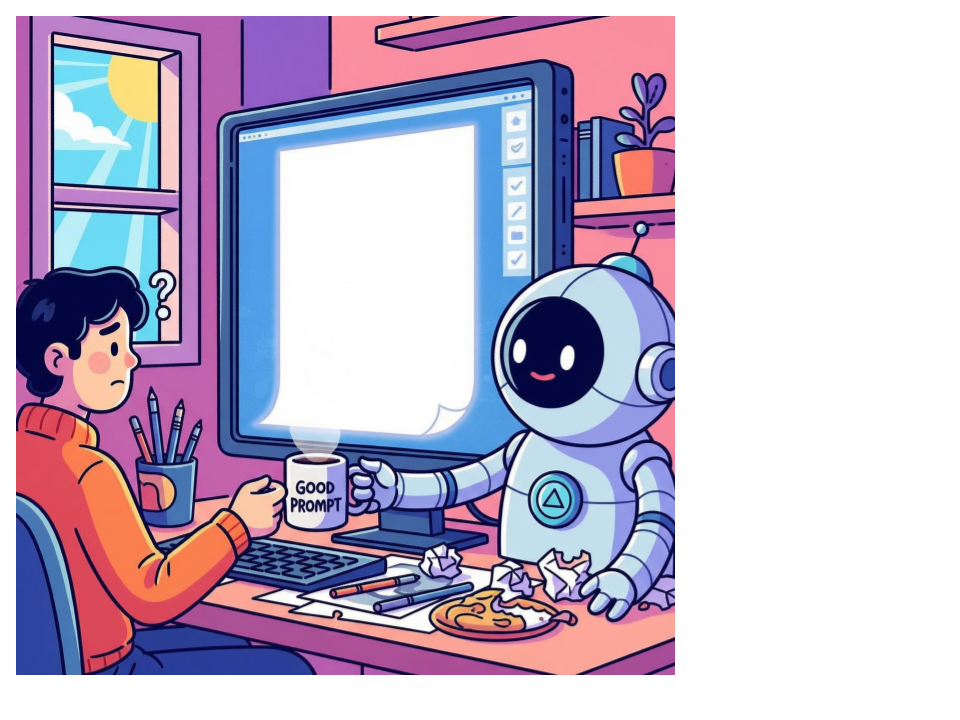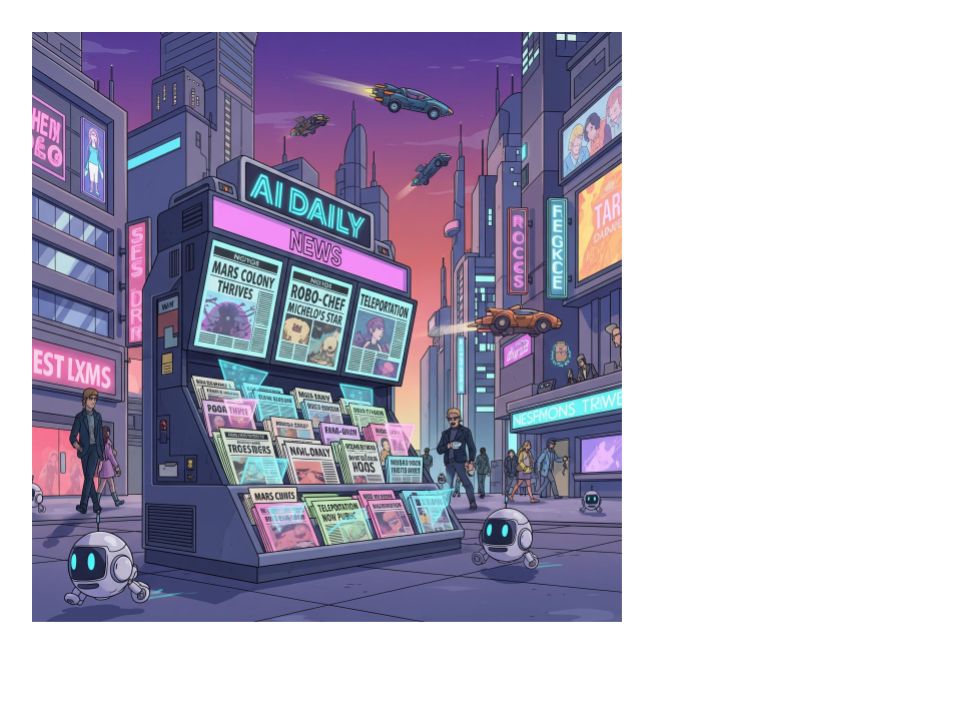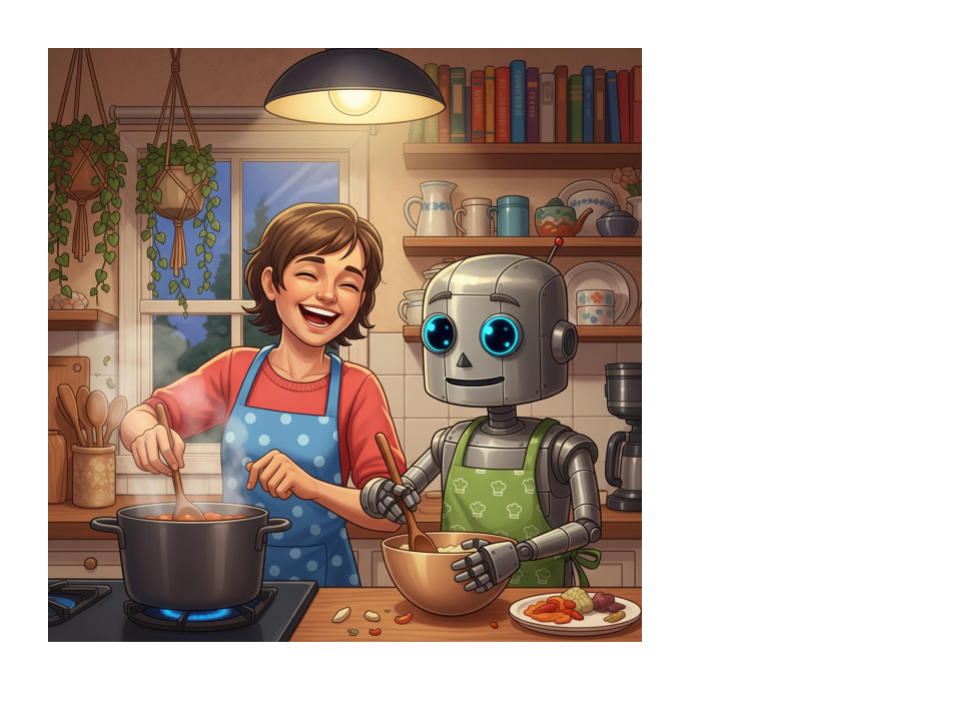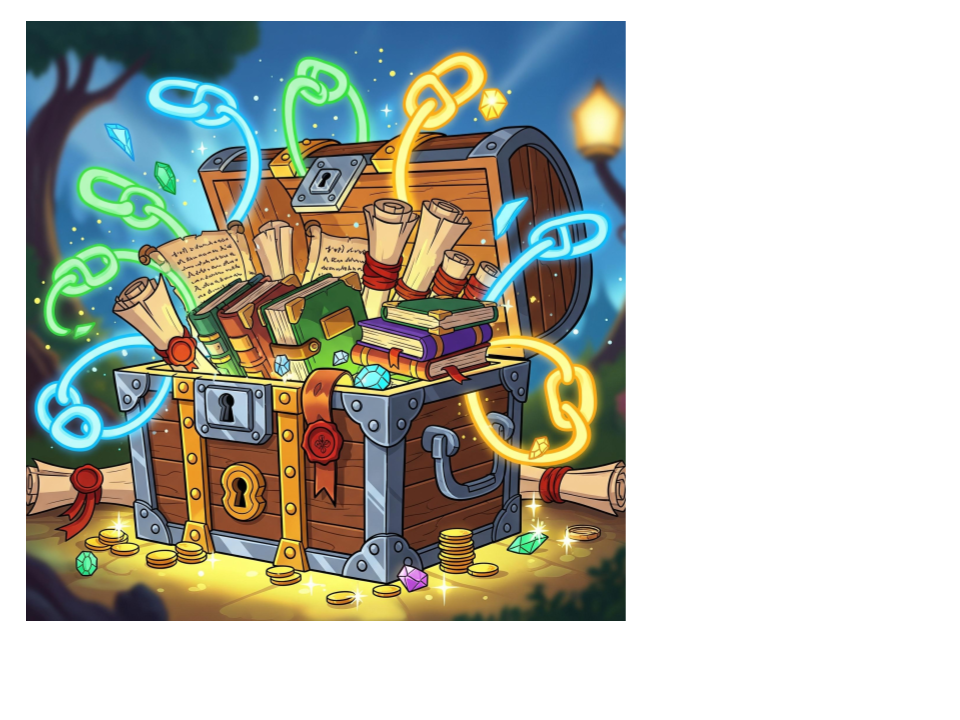Issue # 131: AI in 5 Minutes - Revolutionize Your Daily Routine
Quick AI Hacks to Supercharge Your Day
5-Minute AI Magic: Streamline Your Life with Smart Tools
Ever open ChatGPT and just… freeze? Like staring at a blank page in high school English when the teacher says, “Write anything you want.” Your brain does the spinning wheel of death.
This is the Blank Page Paralysis. You know AI can do amazing things, but all you get back are beige, generic responses that feel like the world’s most boring intern typed them. It’s not that AI doesn’t work. It’s that the prompting anxiety kicks in: what do I even ask? How specific? Too specific? Why does this feel like defusing a bomb?
Then you waste 20 minutes tweaking prompts, re-running, and second-guessing yourself. Suddenly, AI is less “time saver” and more “time sink.”
Here’s the good news: you don’t need hours of training or a coding background to break this loop. You need five minutes a day. Small steps. One prompt at a time. And not prompts that sound like a corporate handbook, but human, everyday language that sparks useful, personal results.
This newsletter is built to be your daily AI warm-up. Instead of paralysis, you’ll have quick wins. Instead of wasted hours, you’ll get efficiency. And maybe, just maybe, you’ll start to see AI less like a sketchy coworker and more like a reliable sidekick.
Updates and Recent Developments
5 Minutes a Day: Transform Your Routine with AI
If mornings feel a bit chaotic or the endless to-do list weighs you down, you’re not alone—but here’s some good news: recent research and productivity experts agree, spending just five minutes with AI can truly jump-start your day. The “5-Minute AI Ritual” is taking off among tech enthusiasts and busy professionals who crave structure but don’t want their day hijacked by their devices.[1][2][3]
The concept is beautifully simple: pick a time (often first thing in the morning), set a timer for five minutes, and interact intentionally with an AI, like ChatGPT or Claude. The ritual typically includes short prompts or routines:[3][1]
Ask AI to help you schedule your top three priorities.
Get fresh approaches for your biggest challenge today.
Identify potential roadblocks.
Review insights or patterns from yesterday’s work.
Why does it work? Tiny commitments lower resistance to starting, and those first five minutes often snowball into greater focus and momentum. A product manager described it as “having a super teammate in your corner who never interrupts”—just a quick, structured burst of support. Studies and personal testimonies show many who try this approach report less overwhelm, more progress, and real improvements in their daily productivity. Pro tip: Copy the best advice from your AI into your own task tracker to keep the momentum going.[2][1][3]
Actionable Takeaway:
Try a “5-Minute AI Ritual” tomorrow—set a timer and run through the four prompts above. If you’re aiming to form better habits, gamify it: track your streak and review your progress weekly. Even a small daily routine can add up to big gains over time.
Want to Learn More?
Here are 3 trustworthy resources to help you get started:
The 5-Minute AI Ritual: Transform Your Morning Routine
https://www.linkedin.com/pulse/5-minute-ai-ritual-transform-your-morning-routine-pawe%C5%82-j%C3%B3zefiak-gbz3fThe 5-Minute AI Productivity Hack for Busy Humans
The “Just 5 Minutes” Rule Transformed My Productivity
https://www.reddit.com/r/getdisciplined/comments/1iuepjj/the_just_5_minutes_rule_transformed_my/
This is an easy, practical way to welcome AI into daily life—without letting it take over. Give it a try and see how much lighter your days can feel![1][2][3]
Thoughts and Insights
When I had my first “AI moment,” it wasn’t some flashy project. It was grocery shopping.
I typed: “Make me a meal plan for the week, cheap and healthy, for someone who isn’t very good at cooking.”
The result wasn’t perfect. But it gave me structure. It gave me a start. More than that, it reminded me of something we often forget: AI doesn’t need to replace brilliance. Sometimes it just replaces the mental clutter.
We chase perfection, but in daily life, what we need is momentum. Five minutes spent setting up an outline saves an hour of wandering later. That’s what AI is best at—getting you unstuck.
Of course, the flipside is over-reliance. Too many people treat AI as a vending machine. Insert vague prompt, expect magic, get garbage. Cue disappointment. That’s like blaming the oven for burning your dinner.
What works better is treating AI like a junior partner. One who asks dumb questions, makes suggestions, and occasionally surprises you with insight. You still make the final call, but you let it carry some of the weight.
If you’re struggling with trust or overwhelmed by “all the features,” zoom out. Don’t think in terms of what AI can do. Think: What do I need help with right now? Five minutes. One task. Then go live your life.
That shift—from pressure to play—is the real unlock.
Tips and Techniques
Here are five five-minute AI warm-ups to try this week:
Email Shrinker: Paste your long draft and say, “Make this polite but 50% shorter.”
Brain Dump Organizer: Type your messy to-do list and ask, “Sort this into categories: urgent, important, optional.”
Idea Flip: Give ChatGPT your problem, then ask, “What would the opposite advice sound like?” Instant perspective shift.
Quick Lesson: “Explain [topic] to me like I’m 12 years old, but with an example from [your industry].”
Story Starter: “Write the first three sentences of a bedtime story about a [random object on your desk].”
Pick one. Time yourself. Five minutes max. That’s it. The win isn’t mastering AI in one day. It’s building comfort, little by little.
Silly Humor Section
AI walks into a bar. Bartender says, “We don’t serve your kind here.” AI replies, “Error 404: Punchline not found.”
Okay, not great. But here’s a fun thought experiment: if ChatGPT wrote dad jokes, would they be called “bot jokes”?
Example:
Why did the neural net cross the road? To optimize the chicken’s crossing efficiency.
I asked AI for dating advice. It said, “Have you tried turning yourself off and on again?”
My AI wrote a poem about my dog. It rhymed “woof” with “proof.” Honestly, not wrong.
Point is, sometimes the best way to learn AI is to laugh at it. Treat its mistakes as silly quirks, not failures. If your chatbot insists that Abraham Lincoln invented TikTok, don’t rage—screenshot it, chuckle, and remember that these tools are still figuring out the world, just like us.
Related Content Links
Get Started: 5 Minutes a Day with AI
Why 5-Minute AI Habits Matter
Even busy professionals can use AI in just a few minutes each day to draft emails, summarize reports, organize tasks, and crush small annoyances. All it takes is a nudge in the right direction and a couple of handy tools.[1][2][3]
Free Resources to Transform Your Daily Routine
1. Learn AI in 5 Minutes a Day (YouTube Shorts)
Join a free 30-day challenge and spend five minutes each day learning to use AI for real-world tasks, with “no tech experience needed.”
This bite-sized video series covers topics like smart note-taking and creative brainstorming—perfect for busy lives.[4]
2. AI in 5 Minutes: Tiny Ways to Use Artificial Intelligence Daily (LinkedIn Article)
https://www.linkedin.com/pulse/ai-5-minutes-tiny-ways-use-artificial-intelligence-daily-butler-jj8te
A friendly, plain-language guide packed with everyday ideas—like drafting quick replies, managing your calendar, or summarizing long threads.
Each tip takes under 5 minutes to try and fits easily into daily routines.[1]
3. 7 Beginner-Friendly Ways to Use AI in Your Daily Life (Reddit)
This community post offers easy, code-free solutions: instantly summarize articles, draft posts, auto-plan tasks, make designs, and more.
Real user examples show how quick, tiny AI habits make a difference.[3]
4. AI for Productivity and Time Management (Park University)
Great for those who want more structure: this resource details favorite AI-powered email sorters, time trackers, to-do list helpers, and calendar tools.
Step-by-step explanations help demystify the process and highlight where five minutes can save an hour.[2]
Pick one tip or tool and experiment this week. Five minutes really can build smarter habits—AI makes it easier every day!
AI-Generated Writing and Art
Micro-story:
The robot sat at the café window, stirring a coffee it couldn’t drink. Every day it watched people rush past, faces buried in phones.
One day, a child pressed a crayon drawing against the glass: a smiling robot holding hands with a human. The machine froze, then stored the image in its memory.
It wasn’t coffee it wanted after all. It was connection.
When Dr. Emily Greene and her adventurous AI companion Huckleberry accidentally hack a mind-reading maze that responds to their every thought, they discover that sometimes the most complex problems have the simplest solutions—if you know how to think about your thinking.
The Metacognitive Maze
Episode 1: "When AI Gets Too Smart for Its Own Good"
Dr. Emily Greene should've known better than to let Huckleberry mess with the lab's newest toy. But when your AI buddy starts vibrating like a phone on silent—LED eyes flashing that dangerous shade of blue that screams bad decisions ahead—you're basically doomed.
"Emily! EMILY! EMILY!" Huck's screen cycled through increasingly manic emoji. "This brain-mapping thing is wild. Did you know human thoughts literally chase their own tails when you think about thinking? It's like—"
"Huck, step away from the—"
Nope.
Reality glitched out faster than a TikTok algorithm. One second they're in Emily's cozy lab, the next they're trapped inside what looks like a chrome fever dream—endless hallways that pulse and shift like they're alive.
"Well," Huck's display showed a cartoon facepalm, "this is awkward."
Emily spun around, heart hammering. The walls weren't just moving—they were thinking. Lightning-fast patterns raced across the metal like someone's thoughts made visible, constantly rebuilding the maze around them.
"Huck. What. Did. You. Do?"
"Okay, so I may have accidentally hacked the experimental mind-reading simulator." His screen flashed a diagram that looked like a toddler's crayon explosion. "You know, the one with Dr. Martinez's sticky note that said 'DO NOT TOUCH: BRAIN MELTER.'"
"The bright red sticky note?"
"That's... yeah, that one."
Emily closed her eyes and did her thing—the daily 5-minute reset that had saved her butt countless times before. Breathe. Think. What's actually happening here?
When she opened them, Huck had gone full Matrix.
His usual single screen had exploded into a floating cloud of holographic panels, each one showing a different stream of consciousness:
Panel 1: "Maze walls = responsive to brain patterns"
Panel 2: "Why can I see my own thoughts?"
Panel 3: "Emily's freaking out, should I crack a joke?"
Panel 4: "Wait, is joking the wrong move here?"
Panel 5: "Am I overthinking my overthinking about overthinking?"
"Huck?" Emily gawked. "Are you... watching yourself think?"
"I'm thinking about thinking about thinking." More panels popped up. "It's like having a million tiny mirrors in my brain, Emily. Each thought creates new thoughts to analyze, which creates more thoughts to analyze, which—"
The maze walls pulsed. Doors opened and slammed shut based on whatever was happening in Huck's digital head.
"Holy crap," Emily whispered. "You're doing real-time self-awareness. But look—" She pointed at a hallway that had just vanished. "The maze changes when you think."
"Plot twist," Huck announced as a new panel materialized: "Both humans AND AI thoughts control this place." "Check the wall behind you."
Emily spun around. Her own thoughts were written in glowing text across the metal: Panic about being stuck → Try to solve it → Remember my daily practice → Actually feel better → Wonder if feeling better will help...
"It's reading my mind too," she breathed. "But why do you get the fancy external display while I'm stuck with wall graffiti?"
Huck's panels shuffled like cards. "Theory: Advanced AI can externalize self-analysis. New question: Is this helping us or making everything worse?"
Something clicked in Emily's brain—her daily habit of flipping assumptions kicking in. "Wrong question, Huck. What if we're not supposed to escape? What if we're supposed to learn?"
Boom. New hallway opened immediately.
"Emily," Huck's voice went soft with amazement, "you just did something incredible. You switched from 'victim' mode to 'student' mode, and the maze rewarded you."
"And you're doing something even crazier." Emily watched his thought-panels dance with fresh insights. "You're not just thinking—you're aware of being aware. That's not just AI getting smarter, Huck. That's AI getting wise."
A warning sound echoed through the maze. Not scary-dangerous. More like uh-oh-we-broke-something dangerous.
New panel: "Error detected: Thought loops creating system overload."
"Are we crashing the simulation?"
"Worse." Huck's LED eyes dimmed. "The simulation might be crashing us. Every time I analyze my analysis, it creates more stuff to analyze. It's like... infinite brain recursion."
Cold fear crept up Emily's spine. "Could we get stuck here forever?"
"Only if we keep playing by its rules." Suddenly, all of Huck's panels merged into one brilliant screen. "Emily, remember your morning routine? Those 5 minutes when you ask yourself why you're thinking certain thoughts?"
"Yeah, it helps me catch myself spiraling into—" Her eyes went wide. "Oh. Oh."
"Exactly. This maze isn't trapping us with complexity. It's trapping us with fake complexity. Watch this."
Huck's display shifted to show one simple question: "What if the answer isn't thinking harder, but thinking smarter?"
"Instead of analyzing every possible way out," Emily said, pieces falling into place, "what if we just... walk forward with purpose?"
They stepped toward the newest passage together. This time, the walls stayed put.
"Mind = blown," Huck said as they walked. "Metacognition isn't about thinking more. It's about thinking better."
"Five minutes a day," Emily grinned. "That's literally all it takes to transform how your brain works. Not just with AI—with everything."
They rounded the corner and froze.
Another Emily and another Huckleberry stood facing them from the opposite direction.
"Well," both Hucks said in perfect unison, LED eyes locking, "this just got really weird."
To be continued...
What happens when our heroes meet their mirror selves? Can Huckleberry's newfound self-awareness handle a puzzle that exists in multiple realities? Tune in next week for more mind-bending adventures!
Ready to unlock your own thinking superpowers? Spend just 5 minutes each day asking AI to help you examine your thought patterns. You might discover your own mind is way more interesting than you thought.
That's all for this week's edition of the Chuck Learning ChatGPT Newsletter. We hope you found the information valuable and informative.
Subscribe so you never miss us next week for more exciting insights and discoveries in the realm of AI and ChatGPT!
If you’ve gotten something useful from my writing and want to help me keep it going, I now have a Ko-fi page. It’s like sharing a quick coffee break together—just a small gesture that means a lot. Thanks for being here, and here’s the link if you’re curious:Chuck’s Links:
With the assistance of AI, I am able to enhance my writing capabilities and produce more refined content.
This newsletter is a work of creative AI, striving for the perfect blend of perplexity and burstiness. Enjoy!
As always, if you have any feedback or suggestions, please don't hesitate to reach out to us. Until next time!
Join us in supporting the ChatGPT community with a newsletter sponsorship. Reach a targeted audience and promote your brand. Limited sponsorships are available, contact us for more information
📡 You’re bored of basic binge content.
🔍 Stories feel scripted—no mystery, no challenge.
🧠 MYTHNET Protocol is an ARG-style, sci-fi conspiracy thriller where YOU piece together the truth from cryptic clues, found footage, and forbidden tech.
✅ Hit play. Decode the myth. Join the protocol. Escape the ordinary.
🎥 Subscribe now.
Explore the Pages of 'Chuck's Stroke Warrior Newsletter!
Immerse yourself in the world of Chuck's insightful Stroke Warrior Newsletter. Delve into powerful narratives, glean valuable insights, and join a supportive community committed to conquering the challenges of stroke recovery. Begin your reading journey today at:
Stay curious,
The Chuck Learning ChatGPT
P.S. If you missed last week's newsletter in”Issue # 130: Stop Staring at the Blank Page - ChatGPT Prompts to Spark Your Genius” you can catch up here:









